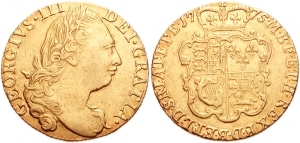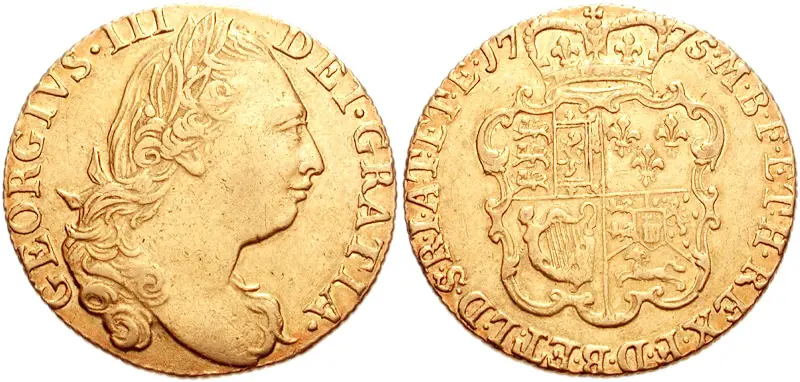The Guinea coin was a legal currency in Great Britain that was minted in the Kingdom of England between 1663 to 1813. It remained a legal tender until 1971 and is no longer used today. The coin, however, still has great value for its gold content alongside historic and collectable context.
Worth £1-1s – or one pound and one shilling – originally, the value of a Guinea changed throughout its circulation due to the changing value of gold at the time. The value ranged from 21 to 25 shillings.
Let’s learn more about the Guinea to understand what they are worth today and how rare they are.
What is a Guinea Coin?
The Guinea Coin was called such because the gold used in the coin was mined in the Guinea region of Africa. It is a coin that is 1 inch in diameter, made of 22-carat gold, and weighs about 8.3 to 8.5 grams.
As mentioned, one guinea was worth £1-1s, which is one pound and one shilling. The equivalent value for today’s money would be £1.05.
The coin was struck from gold and it was the first to be pressed in gold in Britain. The guinea had an aristocratic undertone, as most luxury goods at the time were invoiced the coin as a basis for the costs. Legal fees, costs of medical treatments, tailoring fees, horse bids, horse races, and furniture were priced in guinea.
Today, bids in guinea are still being practised. This is especially prevalent in horse auctions, where the costs are expressed in guinea. When an item or horse is sold, the seller of the horse receives the same amount in pounds.
This means that the auctioneer gets a commission from the cost in guinea coins, which is around 5% of the selling bid of the item or horse.
In other words, if the final selling price of the item is 40 guinea coins, the seller receives £40, but in fact, the actual price is around £42. The extra £2 is taken by the auctioneer as his commission.
The History of the Guinea Coin
The first guinea coin ever produced was on February 5, 1663. It was proclaimed as a legal currency on March 27, 1663. The original worth of the guinea coin was 1 pound or 20 shillings.
The coin was made with a 1-inch diameter, with an average gold purity of 0.91. In other words, the coin is made of 91% pure gold. These coins that were produced between 1663 to 1684 featured an image of an elephant, with some coins featuring an elephant and a castle from 1675 and onwards. The example shown below depicts a Guinea design with a crowned Royal Shield design.

The elephant, with or without the castle, symbolizes the Guinea Coast of Africa, which was involved in slave-trading activities, and credited for the importation of gold into England.
The images on the coin, aside from the elephant and/or castle, featured different designs on the observe and reserve, The observe of the coin features a right-facing bust of Charles II wearing a laurel. Around the coin was the inscription: CAROLS II DEI GRATIA, which means “Charles II by the grace of God.”
The reserve side of the coin featured four crowned cruciform shields that bore the arms of England, France, Ireland, and Scotland. Other features include four sceptres, four interlinked “Cs” and the inscription: MAG BR FRA ET HIB REX, which means, “Of Great Britain, France, and Ireland King.”
The Great Recoinage
The guinea coin was produced and minted until 1813 when the Great Recoinage occurred. This event signalled the change in circulated coins in Great Britain. It was established in an effort to put the UK economy back on track after the Napoleonic War.
From being the major unit of currency, the guinea coin was replaced by the pound in 1816.
The last minted guinea coin occurred in 1813, but it was still in use until 1971 as a legal tender, when the decimalisation occurred.
The £2 Commemorative Coin
In 2013, the Royal Mint issued a £2 commemorative coin for the guinea coin.
The coin was designed by artist Anthony Smith, and it featured a new “Spade Guinea” reworking, as derived from its 18th-century design. At the edge of the coin features an inscription of the quotation by writer Stephen Kemble, which states: “What is a guinea? ‘Tis a splendid thing.”
The commemorative coin was produced to honour the 350th anniversary of the first minting of the guinea coin, and you can learn more about it in our dedicated article here.
How Much Are Guinea Coins Worth?
The guinea coin originally had a value of £1-1s, but the value of a guinea today is far more. The coin is made of 22-carat gold, with most of the coins having 91% pure gold content. The price of the guinea coin today, therefore, depends greatly on the price of gold.
Due to the fluctuation in gold price, the Guinea was worth somewhere between 21 to 25 shillings when it was used in circulation in Great Britain. With the Gold Standard introduced in 1717, however, the guinea coin’s worth was fixed at 21 shillings from 1717 to 1816, when it ceased to become the major unit of currency in the Kingdom of England.
Each coin weighs about 8.3 to 8.5 grams, which is equivalent to about one-quarter of an ounce of gold.
A guinea’s worth today depends on the price of gold at the moment one sells it. Since only about 91% of the guinea coin is made of pure gold, that means the gold content is about 7.55 grams. Let’s calculate a guinea coin’s worth using this gold content and weight.
For example, if the price of gold today is at £33 per gram, and the weight of gold in a guinea coin is at 7.55 grams, that would mean the worth of a guinea coin now is at £241.60.
While this is the worth of the guinea coin based on its gold content, its true price can go higher if you sell it to a collector. Coin collectors value the guinea coin higher than its gold content and could offer a higher price depending on the era, condition of the coin, and rarity. A guinea coin can fetch as high as £1000 with the right collector.
Final Summary
The guinea coin was a legal tender and the major form of currency in Great Britain between 1663 to 1816, although it was still accepted as a legal tender until 1971.
The coin is made of 22-carat gold with a weight between 8.3 to 8.5 grams, making its worth dependent on the price of gold at the moment sale. However, when sold to a coin collector who highly regards the guinea coin, its value can go up depending on its rarity, era, and condition.
